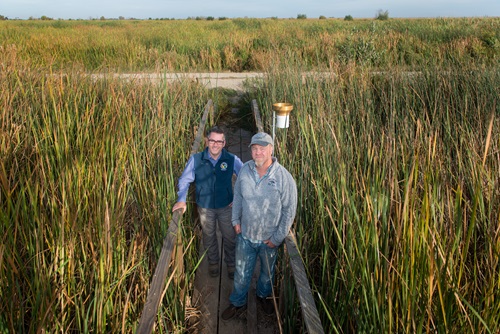Sustainability

DWR employees at Twitchell Island in the Sacramento-San Joaquin River Delta. DWR/2016
Sustainability is a broad concept that, depending on specific circumstances, means different things to different people. However, all concepts of sustainability share the fundamental theme of assuring enough resources for both current and future generations. Sustainability is about using our resources wisely and adapting to change.
Water resource issues in California are complex and dynamic, and the planning we do as a department must ensure that Californians will enjoy clean water and thriving ecosystems far into the future. Some of the water supply sustainability challenges we face include:
- Climate change, which impacts water supply and delivery
- Increasing population and demands on finite water resources
- Ecosystem fragmentation and decline, which has put many species on threatened or endangered lists, requiring regulations to protect them
- Increasing sources of contaminants that impact water quality
- Invasive species that disrupt operation of water delivery systems
Ensuring sustainability requires that we address complex issues within our state borders, and beyond. On a regional and local scale, we work to protect watersheds, conserve and protect groundwater basins, and implement energy efficiency in buildings. On a larger scale, we work with our partners to address global warming and climate change, the impacts of non-biodegradable materials, deforestation, endangered species, and desertification.
Sustainability is our Mission
DWR's mission to protect, restore and enhance the natural
and human environment embraces sustainability. Sustainability is a fundamental
principle in our planning documents, such as the California Water Plan, the
Climate Action Plan, and the Water Action plan. Sustainability is in DWR’s
restoration projects, fish passage improvements, flood plain enhancements, and
environmental research projects and studies.
The California Water Plan, updated every five years, addresses water sustainability. We developed the California Water Sustainability Indicators Framework (CWSIF), part of the Water Plan, to further California’s sustainable water management and proactive response to changing availability and constraints on water. The evaluation of these sustainability indicators reveals how our actions or inaction can degrade or improve conditions that lead to water sustainability.
In 2010, DWR established the Environmental Stewardship Policy to advance a department-wide “Total Resource Management” approach to planning and design of projects. By building environmental benefits into projects on a meaningful scale, the Department supports sustainability from an engineering, economic, social, and environmental perspective.
Increased concentrations of GHGs in the atmosphere are the principal cause of anthropogenic climate change. California has established GHG policies and reduction goals as the scientific connection between GHG emissions and climate change has strengthened. DWR’ s own reduction strategies for GHG emissions are consistent with those policies and goals.
DWR is implementing 11 GHG emissions reduction measures. These 11 GHG emissions reduction measures include DWR’s termination of its interest and associated delivery of electricity from a coal-fired power plant, efficiency improvements to DWR’s existing facilities, purchase and development of renewable and high efficiency electricity supplies, comprehensive improvements to DWR’s construction practices, and improvements to DWR’s business activities that will reduce GHG emissions. These measures will reduce annual GHG emissions in 2020 by more than 1.1 million metric tons and by more than 2.5 million metric tons in 2050.
Read more about DWR's plan to cut down on climate emissions in our Climate Action Plan.The Sustainable Groundwater Management Act (SGMA) established a framework for sustainable, local groundwater management. SGMA requires groundwater-dependent regions to halt overdraft and bring basins into balanced levels of pumping and recharge. SGMA:
-
Establishes a definition of “sustainable groundwater management”
-
Requires a Groundwater Sustainability Plan for the most important groundwater basins in California
-
Establishes a timetable for adoption of Groundwater Sustainability Plans
-
Empowers local agencies to manage basins sustainably
-
Establishes basic requirements for Groundwater Sustainability Plans
-
Supports a limited state role
IWM embraces a holistic approach to managing water resources. One of IWM’s guiding principles is to manage water together with its codependent natural resources, namely soil, forests, air and biota. Our IWM activities focus on multi-benefit projects that support water resources and flood management planning, while restoring ecosystems. The long-term reliability of our water supply depends upon healthy ecosystems.
Sustainability in our Operations
DWR has adopted sustainability as one of its core values. To help in its sustainability effort, DWR has a Sustainability Coordinator, a Sustainable Business Operations Unit, a Climate Action Unit, a Water and Energy Efficiency Branch, 33 Recycling and Waste Coordinators, LEED-certified staff, environmental scientists, biologists, engineers, rangeland scientists, hydrologists and other specialists who are integrating sustainability into their daily work.
Some of DWR's Sustainable Operations achievements include:
DWR’s 5-year average of GHG emissions for 2011-2015 is 1.3 million metric tons of carbon dioxide emissions (mtCO2e). This number is 52% below 1990 levels and 49% below 2010 levels and the lowest ever recorded by DWR. DWR is well ahead of schedule for achieving its 2020 and 2050 GHG Emissions Reduction Goals. In fact, DWR achieved its target emissions reductions for 2020 in 2015, five years ahead of schedule.
DWR has met the water reduction requirements of twenty percent from the 2010 baseline as well as the drought emergency requirement of 25 percent reduction from the 2013 baseline. Overall, DWR has reduced its per capita consumption from 119 gallons to 74 gallons in 2016.
